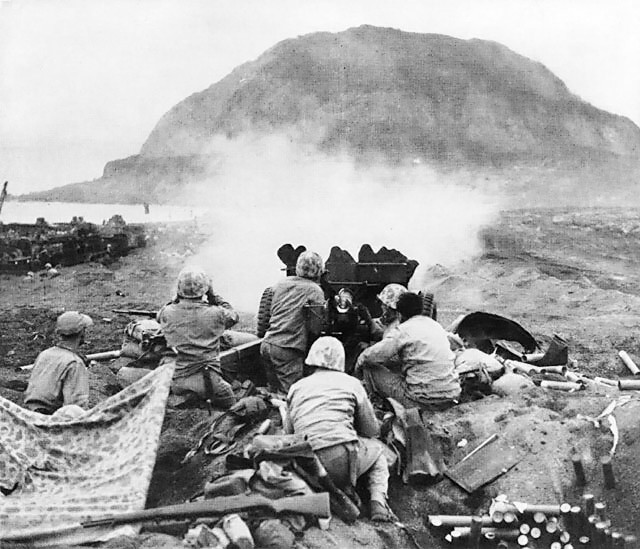Beginning on February 19th, 1945, the United States Marine Corps launched “Operation Detachment”, which aimed to capture the island of Iwo Jima from the Imperial Japanese Army. Iwo Jima, only 750 miles off the coast of Japan, had three airfields which could facilitate a potential invasion of mainland Japan by United States Forces. Japan was significantly weakened at this point in the war from a myriad of losses in the Pacific, making their island holdings vulnerable. Because of this, taking the island was initially seen as an easy task. However, an invasion that was predicted to last just a few days ended up lasting four weeks.
The United States Marines began the invasion with an amphibious landing on the island. The Marines were almost immediately faced with challenges as the beaches had high slopes of soft volcanic ash that were extremely difficult to navigate both in military vehicles and on foot. Taking advantage of the Marines’ precarious situation, the Japanese began to fire upon the American forces who did not have adequate protection. The beaches became a death trap and U.S. forces suffered greatly. It took much longer than anticipated for U.S. forces to move beyond the beaches to areas where they could take cover. The Marines were eventually able to advance past the beaches and take control of one of the island’s airfields by nightfall.
Finally off the beaches, American troops were able to move forward with more effective offensive pushes and cut the Japanese off from supply lines. Although the Americans were incurring heavy losses, the Japanese were losing more men and quickly began to run low on supplies. U.S. Marines captured Mount Suribachi, a volcanic mountain on the southwest end of the island, four days after fighting began. The mountain was one of the most important locations on the island from a tactical standpoint, as the view from the summit made it easy to spot and destroy enemy forces. Marines raised a flag on the summit of the mountain in a mostly symbolic gesture, as victory was still far off. The first flag was eventually taken down by the Secretary of the Navy, who wanted it as a souvenir. On February 23, members of an American rifle squad were sent back up the mountain with a much larger flag to raise on Suribachi’s summit. They were accompanied by Joe Rosenthal, a photographer for the Associated Press, and a few Marine photographers. As the Marines began raising the flag, Rosenthal snapped one of the most iconic photos of WWII. The photo would go on to win a Pulitzer prize.
American forces greatly outnumbered the Japanese on the island. However, the Japanese put up a formidable fight, mounting various successful surprise attacks under the cover of darkness. It is estimated that U.S Forces suffered over 25,000 casualties (casualties include both injuries and deaths) throughout the weeks of fighting. Despite these successes, the Japanese forces were weakened by heavy losses and a lack of weapons and food on the island. On March 25, 1945, the Japanese forces launched their final attack, but the Americans emerged victorious. The next day, the American forces declared victory, but the fighting on Iwo Jima was not over. Some Japanese soldiers remained on the island, refusing to surrender. Two Japanese soldiers continued fighting on the island until finally being captured and surrendering in 1949, four years after the war had ended.
Although initially American military leaders thought Iwo Jima was of great strategic importance, this never truly panned out. The damage done to the island and the losses incurred as a result of the fighting made it no longer suitable as an area to stage forces, because most of its infrastructure was destroyed. Additionally, despite earlier aspirations of utilizing the island as a base for launching an invasion of the Japanese mainland, this invasion never took place. 27 men who served in Iwo Jima received Medals of Honor, the most awarded for any battle in U.S. history.
Suggested Reading:
The National WWII Museum: Iwo Jima
Derrick Wright, The Battle for Iwo Jima 1954 (Sutton Publishing, 2006)








